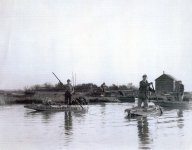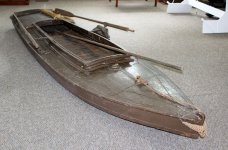Richard Lathrop
Active member
Looking at photos from the 1950's and earlier I noticed that duck boats were not grassed. When did this become common?
Rick Lathrop
Rick Lathrop





Richard~Thanks, photos like this had me wondering.

1950s MAN DUCK HUNTER ROWING DUCK BOAT DECOYS ON REAR DECK AND KILLED DUCKS ON FRONT BARNEGAT BAY NJ USA Stock Photo - Alamy
Download this stock image: 1950s MAN DUCK HUNTER ROWING DUCK BOAT DECOYS ON REAR DECK AND KILLED DUCKS ON FRONT BARNEGAT BAY NJ USA - G6A5CC from Alamy's library of millions of high resolution stock photos, illustrations and vectors.www.alamy.com
and this one.

1920s 1930s SENIOR MAN DUCK HUNTER STANDING IN SNEAK-BOX BOAT ABOUT TO DEPLOY DECOYS IN BARNEGAT BAY WETLANDS MARSH NEW JERSEY Stock Photo - Alamy
Download this stock image: 1920s 1930s SENIOR MAN DUCK HUNTER STANDING IN SNEAK-BOX BOAT ABOUT TO DEPLOY DECOYS IN BARNEGAT BAY WETLANDS MARSH NEW JERSEY - AAKWTR from Alamy's library of millions of high resolution stock photos, illustrations and vectors.www.alamy.com
but then you have this photo from same set.

1920s MAN DUCK HUNTING STANDING IN SNEAKBOX BOAT IN MARSH AiMING SHOTGUN BARNEGAT BAY NEW JERSEY USA Stock Photo - Alamy
Download this stock image: 1920s MAN DUCK HUNTING STANDING IN SNEAKBOX BOAT IN MARSH AiMING SHOTGUN BARNEGAT BAY NEW JERSEY USA - FPW1GJ from Alamy's library of millions of high resolution stock photos, illustrations and vectors.www.alamy.com
